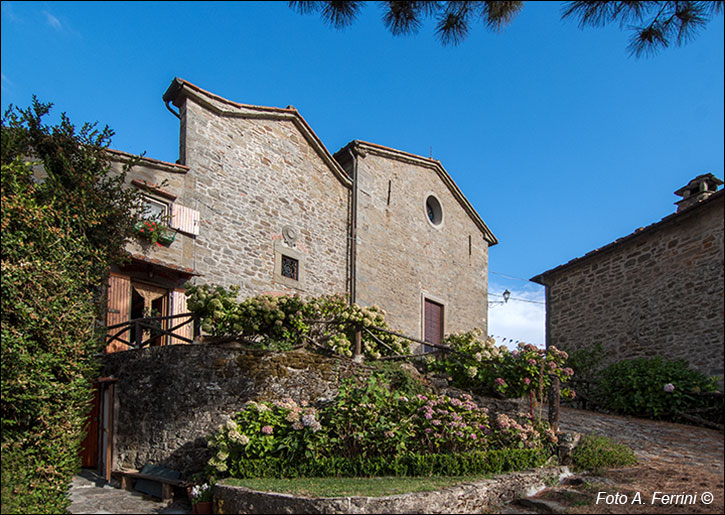Da un antico castello all’erboso crinale
itinerario sul Pratomagno valdarnese: da Trappola alla Bottigliana e alla Pozza Nera
Italiano
ITINERARIO TRAPPOLA – CIMA BOTTIGLIANA – POZZA NERA 3
La Chiesa di San Jacopo a Trappola. Questo sacro edificio nasce come cappella del castello medievale e il suo stile era sicuramente romanico. Per i rifacimenti e restauri di cui è stato oggetto nel corso dei secoli, nulla è rimasto dell’impianto originale. Sulla finestra nella parete accanto alla chiesa è scalpellata la data 1617. Potrebbe essere il momento di una ristrutturazione da parte della potente Famiglia Ricasoli di Firenze che era divenuta proprietaria di questo territorio dal 1564, quando gli fu donato dal Duca Cosimo I dei Medici in riconoscenza d’importanti servigi che alcuni membri di questa casata avevano dato durante la guerra contro Siena. La parte alta della parete, così come parti architettoniche interne della chiesa, riconducono, invece, ad uno stile più barocco, ossia un centinaio di anni più avanti. Anche un’opera posta dietro l’altare, di autore ignoto, potrebbe essere databile inizio XVIII secolo. Rimanendo in tema di arte, piacevole è anche un dipinto moderno che mostra San Jacopo con il Pratomagno sullo sfondo. Passando all’artigianato, invece, ancora nella chiesa è da vedere un organo realizzato negli anni ’70 dell’Ottocento da Demetrio Bruschi, un falegname di Loro Ciuffenna che dapprima si specializzò nel restauro di organi, poi iniziò a costruirli. Attorno al 1890 gli si affiancò il figlio Onofrio. Insieme divennero una nota azienda costruttrice di organi. I loro lavori sono presenti in varie chiese del Valdarno e non solo. Un organo di fine Ottocento di particolare raffinatezza è presente nella Pieve di San Martino a Vado a Strada in Casentino.The Church of San Jacopo a Trappola. This sacred building was born as a medieval castle chapel and its style was certainly Romanesque. Due to the renovations and restorations it has undergone over the centuries, nothing remains of the original structure. The date 1617 is chiseled on the window in the wall next to the church. It could be the time of a renovation by the powerful Ricasoli family of Florence who had become owners of this territory since 1564, when it was donated to them by Duke Cosimo I dei Medici in gratitude of important services that some members of this house had given during the war against Siena. The upper part of the wall, as well as the internal architectural parts of the church, lead, however, to a more baroque style, i.e. a hundred years later. A work placed behind the altar, by an unknown author, could also be dated to the early 18th century. Staying on the subject of art, a modern painting showing San Jacopo with the Pratomagno in the background is also pleasant. Moving on to craftsmanship, however, still in the church you can see an organ made in the 1870s by Demetrio Bruschi, a carpenter from Loro Ciuffenna who first specialized in the restoration of organs, then began to build them. Around 1890 his son Onofrio joined him. Together they became a well-known organ manufacturing company. Their works are present in various churches in Valdarno and beyond. A particularly refined late nineteenth-century organ is present in the Pieve di San Martino a Vado a Strada in Casentino.




























































































